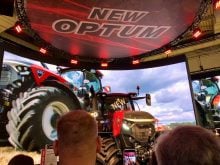DENVER, Colo. – The debate over mandatory country-of-origin labelling in the United States is far from over, say American meat industry experts.
“It is not through, not by any stretch of the imagination,” said Herb Meischen of Cargill Meat Solutions, one of the speakers at the International Livestock Congress held in Denver Jan. 13.
Derrell Peel of Oklahoma State University agreed.
“I am under no illusions this is the end of the story …. This is a rule that will never make everybody happy. COOL is and will continue to be a controversial issue,” said Peel, who has spent a decade studying the law that goes into effect March 16.
Read Also

Agritechnica Day 2: The future of tractor power, building quicker crop apps and large farms and tech
Agritechnica Day 2: The future of tractor power, building quicker crop apps with Syngenta and large farms and tech
“Both the benefits and costs of COOL remain uncertain. This is a really good example where a relatively simple and fairly obvious notion … has proven to be enormously complicated to implement.”
The final rule was published in the U.S. federal register Jan. 15 with minor changes that may help Canadian cattle and hog exporters, said Burton Eller, who is in charge of government affairs for the National Cattlemen’s Beef Association and until August was an employee of the U.S. Department of Agriculture.
The rule covers red meat, poultry, fresh and frozen produce, ginseng, peanuts, pecans and macadamia nuts.
There are four label categories for beef and pork: the A label is designated for U.S. origin products, B is for multiple countries, C is imported for immediate slaughter and D indicates imported meat.
The changes allow commingled product labels to list countries in any order. Therefore, an entire day’s production at a meat plant can use one label rather than sorting and segregating livestock as to whether they were born in Canada or the U.S.
Ground meat must list all possible countries in any order.
Normal business records to document animal origin are acceptable.
Because animals had to be segregated according to interim COOL rules, Canadian and Mexican livestock exporters claimed a major trade disadvantage because U.S. packers offered discounted bids by $40 to $100.
“There is more flexibility, but is it enough to take the discount off? I don’t know,” Eller said in an interview.
Packers will decide what their approach will be.
Proponents of the original bill argued it would provide a price bonus to American producers for domestic beef as well as tell consumers where their food came from. Eller said that was a mistake because U.S. beef is so plentiful in the domestic market.
“COOL is not a niche marketing tool,” he said. “U.S. beef is not putting a penny in my pocket for my calves that I am selling …. What it has done is devalued cattle we were importing from Canada or Mexico.”.
As well, the restriction reduced the number of foreign born feeder calves coming into the country, which strained American feeders at a time when some were losing as much as $150 US per head in recent months. If feedlots or packers go out of business, they are unlikely to return.
“This will set a precedent we won’t turn around for a long time,” Eller said.
However, Monty Brown, a British-based processing and retail consultant for the U.S. Meat Export Federation, said the U.S. needs to get serious about providing traceability on its meat products.
Country-of-origin labelling was put in place in Britain in 1997 following that country’s BSE crisis, he added.
About 80 percent of the beef and 70 percent of the pork sold in Britain is domestic product and is labeled as such on every package. All beef and veal must indicate country of origin, slaughter date, batch numbers, prices, weights and cooking instructions.
Brown said animal identification and traceability records are important in Europe, while they are resisted in the U.S.
“We find it strange you can put a man on the moon but you can’t tell if the cow 15 miles away had a calf.”















